Last Updated on: July 9, 2024
Alabama is amazing, especially for birdwatching!
The Yellowhammer State is home to more than 400 bird species. Many of them are year-round residents. Some are migratory birds.
However…
With the hundreds of birds that consider Alabama their home, identifying the flying creatures in the state is challenging. To the untrained eye, many of these birds look the same.
Confused with the birds in Alabama? No worries! Read on and we’ll walk you through some of the species you will find in the state, as well as their physical characteristics, feeding behaviors, and habitats.
Listing Down The Most Common Birds In Alabama
1. Blue Jay
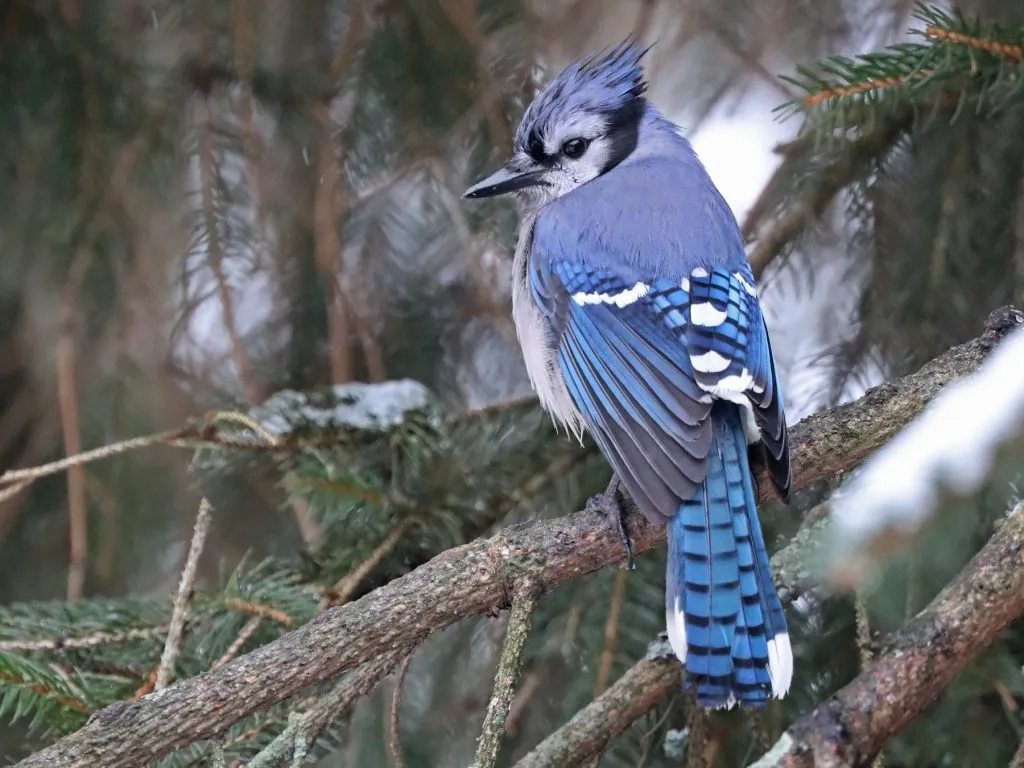
One of the most colorful backyard birds in Alabama, the blue jay is easily recognizable. They have different shades of black, white, and blue. Underneath, it is either light gray or white.
You will find a blue jay in Alabama throughout the year. In the winter, some of these birds will migrate to the west.
If you want to lure blue jays, you must have bird feeders with suet, sunflower seeds, and peanuts. You can also entice them in a bird bath.
Blue jays are known for their vocalizations. They are amongst the noisiest birds. They can mimic the calls of hawks.
2. Eastern Bluebird

Another year-round resident in Alabama, eastern bluebirds live in meadows. You will also often see them on low branches, telephone wires, and posts.
The eastern bluebird has a slightly different coloration depending on gender. Males have vibrant blue upper bodies with rusty chests and throats. On the other hand, females are often duller.
Insects, berries, and wild fruits are the most common foods of eastern bluebirds. Occasionally, it can also eat large prey, including tree frogs, lizards, salamanders, and snakes.
If you have a spacious backyard, install nest boxes to attract eastern bluebirds. Offering mealworms will also work if you want to lure these birds.
Lastly, the eastern bluebird is a skilled flier. It also has an incredible vision, allowing it to spot insects even when the bird is flying at a height of up to 60 feet.
3. Red-Bellied Woodpecker

With its name, you might expect that it has a vibrant red belly, However, while it is indeed red, a red-bellied woodpecker is pale and almost unnoticeable.
One of the most prominent characteristics of red-bellied woodpeckers is the red cap. Nonetheless, take note that it is present only in females. Both sexes have black and white markings.
Red-bellied woodpeckers will eat insects, nuts, seeds, and spiders. They can even feed on nestlings.
In houses next to wooden areas, it is easy to attract a red-bellied woodpecker in bird feeders, especially when there are black oil sunflower seeds, suet, and peanuts.
You will often see red-bellied woodpeckers hitching on the trunks and branches of trees. They have a habit of picking bark surfaces instead of drilling.
4. Northern Cardinal

The list of the most common backyard birds in Alabama is incomplete without mentioning the northern cardinal. From summer to winter, these birds are present in the state throughout the year.
Males an unmistakable because of their bright red plumage. It stands out because of the black mask that complements the red body. Meanwhile, female northern cardinals have brown bodies, red beaks, and red highlights.
The most common place where you can find a northern cardinal is in an area with dense vegetation. This is where the bird looks for insects, fruits, and seeds to eat.
Northern cardinals can go to bird feeders, especially when you offer them peanut hearts, millet, and sunflower seeds. They will eat on large platforms and tube feeders.
5. Yellow-Rumped Warbler

The yellow rump patch is the most recognizable physical feature of these winter birds in the Yellowhammer State, which is most visible when it is flying.
It also has a yellow patch on the face. Meanwhile, the wings are gray, black, and white. Males are brighter than females. Both sexes are duller in the winter than they are in the summer.
If you want to include yellow-rumped warblers in your Alabama bird watching itinerary, some of the best places to check out are open coniferous forest edges. They also thrive in deciduous forests, but sightings are rarer.
6. Mourning Dove
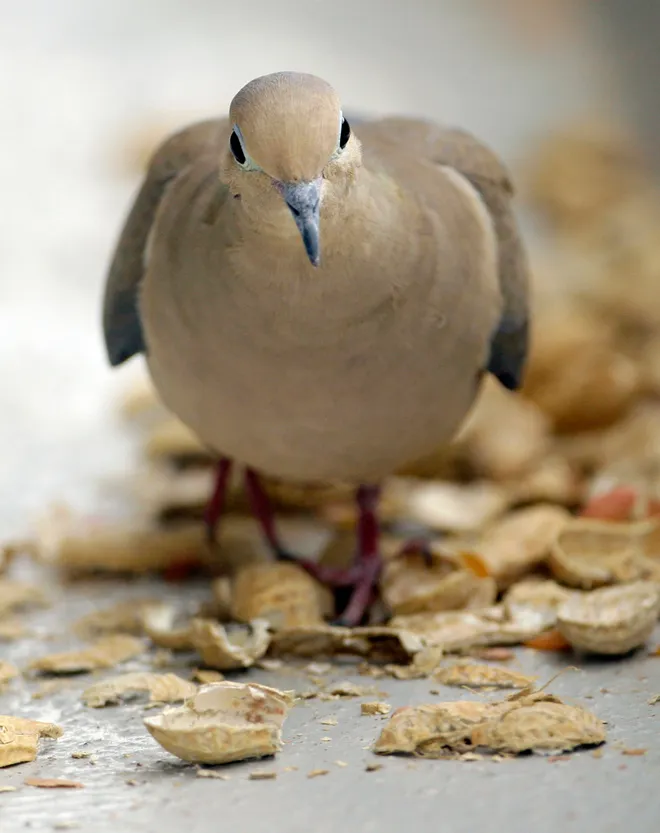
About the same size as the American robin, the mourning dove is a graceful and slender bird with an average length of 9.1 to 13.4 inches and a wingspan of 17.7 inches.
Mourning doves are grayish brown in most parts of the body with black spots on the wings. Meanwhile, they have black tail feathers with white tips.
More than their color, mourning doves are easy to spot because of their songs. They make sad calls, which are reminiscent of mourning. This is where the bird got its name.
The mourning dove has a wide distribution as you can see it almost everywhere except in deep wood. They are also frequent backyard visitors, especially if you have platform bird feeders with millet, cracked corn, and sunflower seeds.
7. Northern Flicker
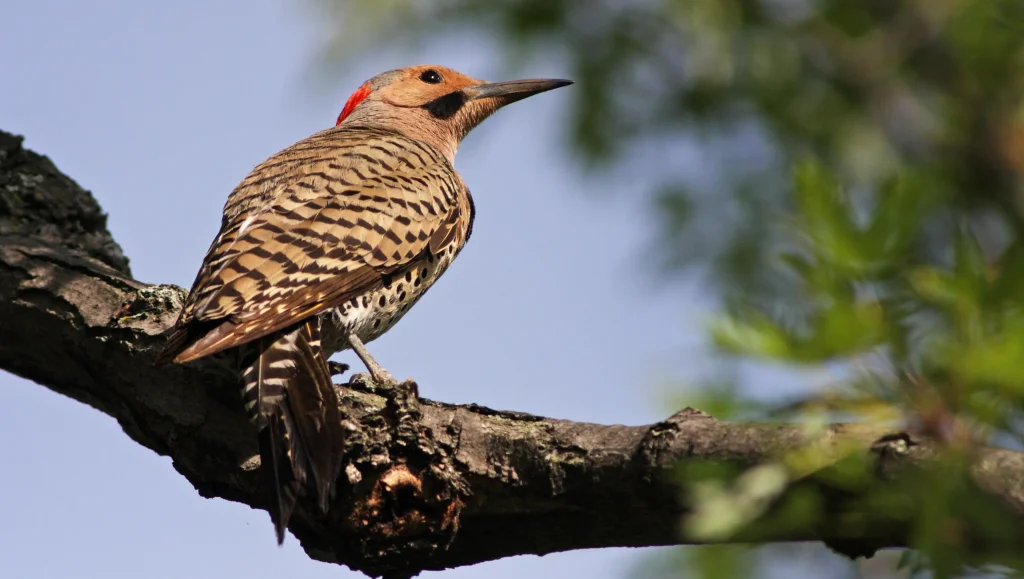
The northern flicker is the state bird of Alabama, so it is just right that it earns a spot on our list. You will find them in the state throughout the year.
Those who are searching for a northern flicker should head to open habitats with trees, including parks, yards, and woodlands.
The easiest way to attract northern flickers to the backyard is by installing bird feeders. They will also visit places with beetles, ants, fruits, and seeds, which form most of their diet.
Northern flickers prefer to stay on the ground when it is looking for food. Nonetheless, they can also climb trees and hammer barks like other woodpeckers.
8. Carolina Wren
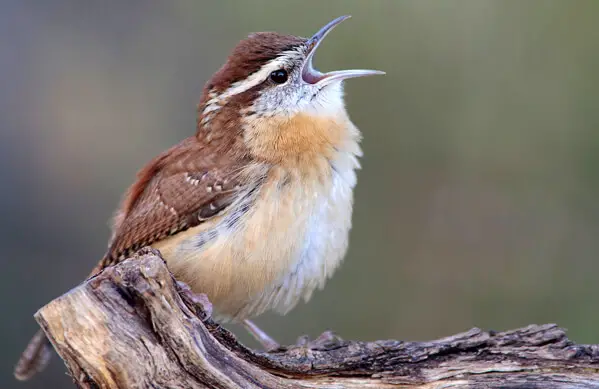
Dark brown on top and light brown under the body, the Carolina wren is not as colorful as the other birds on this list. They can be quite difficult to spot, especially when they are hiding.
To identify a Carolina wren, you should look at its upright tail and white eyebrow stripe. In addition, the bird also has a long and curved beak.
Keep an open ear to detect the presence of these common backyard birds in the Yellowhammer State. They have a loud song that you can easily recognize before you even see these birds.
9. House Sparrow
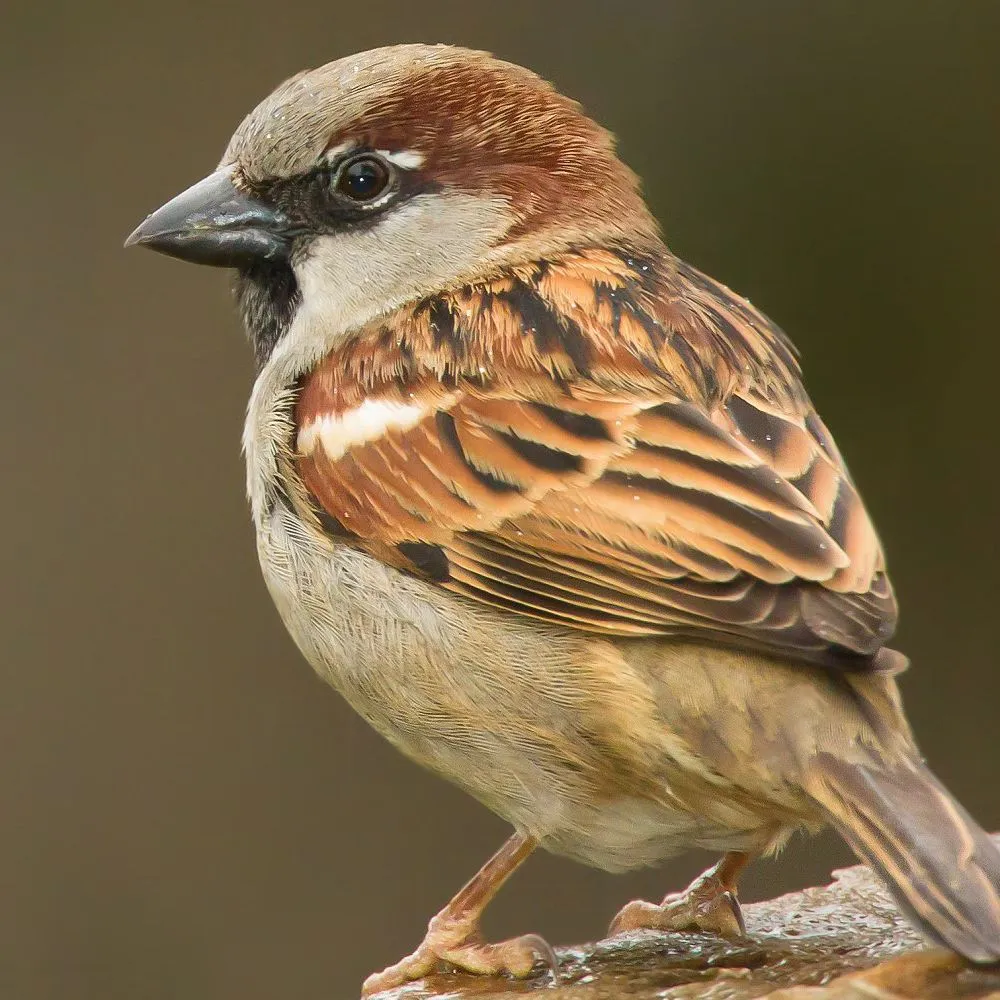
The physical features of house sparrows vary slightly depending on their gender. Males have white cheeks, a black bib, chestnut sides, and a gray crown. On the other hand, females are dull brown with black streaks on the back. The lower body is light brown.
With their adaptability, it is common to see house sparrows even in locations with human settlements. They can also come to bird feeders, especially those with milo, millet, and cracked corn.
While they are amongst the most abundant birds in the state, they are considered invasive species. Hence, many people do not like seeing them in their backyards.
One of the reasons why a lot despise these birds is because they compete with the nests of native birds, including bluebirds.
10. Red-Winged Blackbird
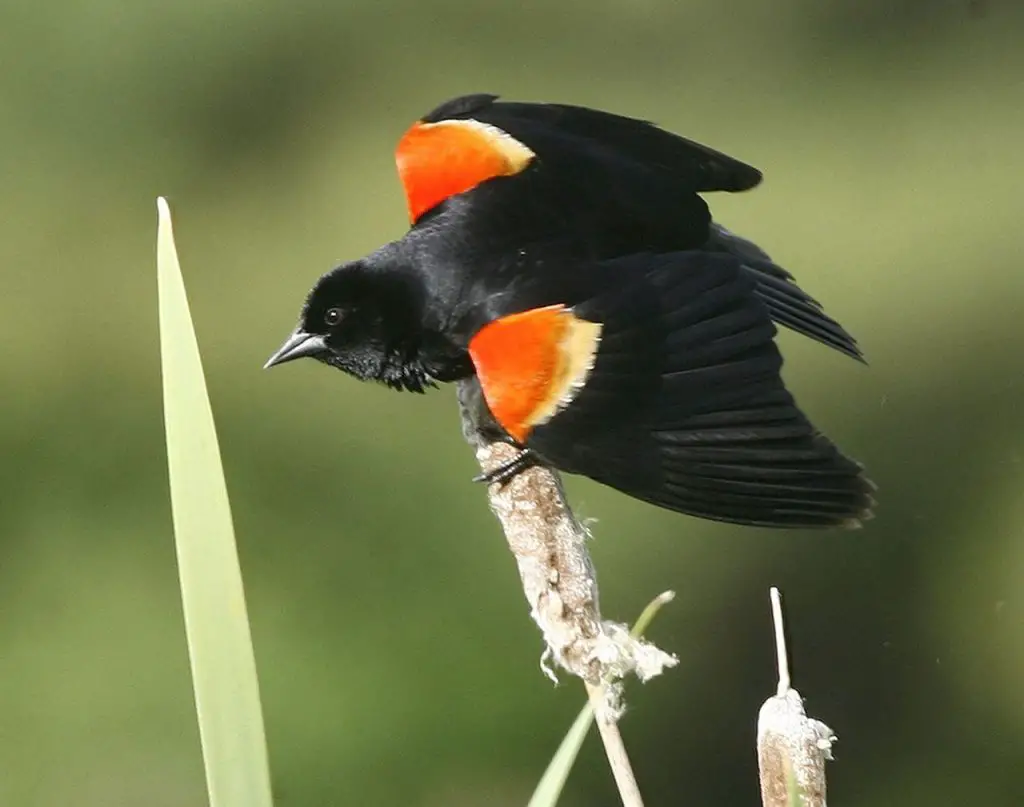
It is quite easy to identify a red-winged blackbird when you see one. Their plumage can vary depending on gender. Males are all black, but they have a red and yellow coloration on the shoulders. Females, on the other hand, are brown with heavy streaks and a hint of yellow on the bill.
Red-winged blackbirds are most abundant in wet areas, including marshes, especially during the breeding season. Outside of the latter, they frequent pastures, farm fields, and grasslands.
It is not uncommon to find red-winged blackbirds as part of a massive flock along with starlings, cowbirds, and grackles.
11. Northern Mockingbird
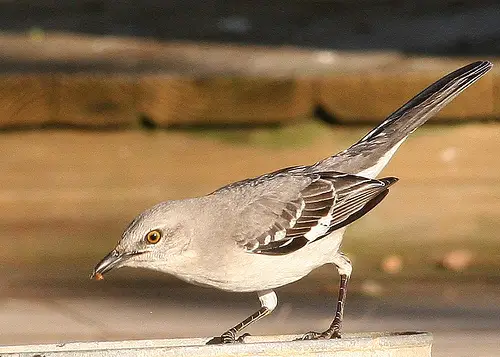
When talking about Alabama backyard birds, it is almost impossible to not mention the northern mockingbird. It has gray-brown upperparts and white outer tail feathers. It also has two bold white wing bars.
Northern mockingbirds reside in Alabama throughout the year. It is common to find them in pairs. They are aggressive, especially when they are defending their territories.
Do you want to attract a northern mockingbird to your backyard? They are not fans of bird feeders, but you can lure them when you have mulberries and hawthorns, among other fruiting trees and shrubs.
12. Downy Woodpecker

Present in Alabama year-round, downy woodpeckers are common in open woodlands, especially those with woody edges and deciduous trees. You will also see them in vacant lots, orchards, yards, and city parks.
The checkered black and white pattern is one of the defining characteristics of downy woodpeckers. Males are distinguished from females through the small red patch on the back of the head.
Downy woodpeckers will eat mostly insects, including ants, beetles, caterpillars, and gall wasps. Berries and seeds are also parts of their diet.
13. Chipping Sparrow

A slender bird with a fairly long tail, the chipping sparrow has a gray belly with brown and black streaks at the back. The crown is rusty while the eye line is black. Come winter, their colors become duller.
Open grounds are the preferred habitats of chipping sparrows, which is where they spend time as a small flock. You can also find them in parks and backyards.
Scatter black oil sunflower seeds and mixed seeds on the ground if you want to attract chipping sparrows. Alternatively, you can also see them visiting backyard feeders.
14. House Finch
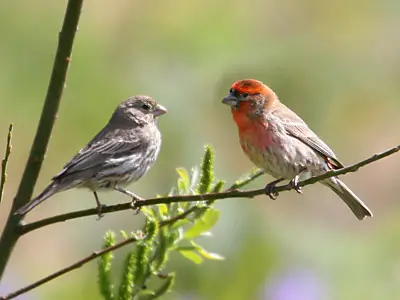
Throughout the year, you will find house finches in Alabama. They remain in the state whether it is winter or summer.
The house finch is almost guaranteed to turn heads. Males are rosy-red in the upper breast and face. The tail, belly, and back have brown streaks. When they are flying, the red rump is visible. Females, on the other hand, are gray-brown with blurry streaks.
While house finches stay in bird feeders, they also feed on the ground. They move slowly when searching for food, which includes berries, buds, and seeds.
Some of the natural habitats of a house finch include farms, urban centers, backyards, forest edges, and city parks.
15. Ruby-Throated Hummingbird
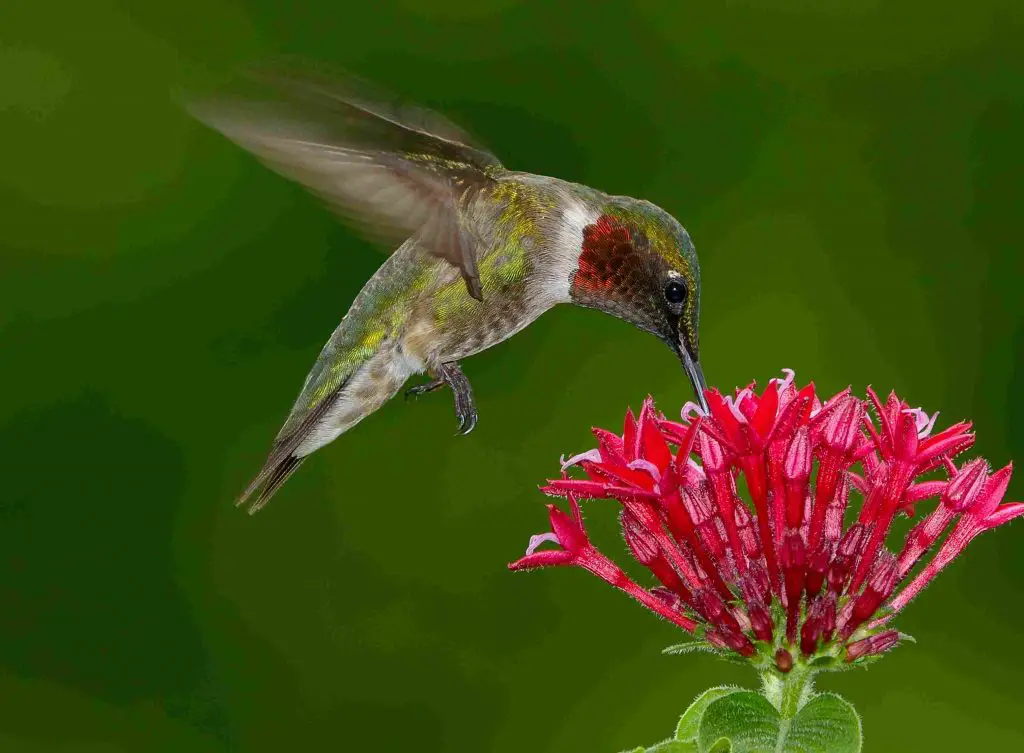
In the warm summer months, you will see ruby-throated hummingbirds in Alabama. Once winter arrives, on the other hand, they move to Mexico.
If you are unsure if it is a ruby-throated hummingbird you are seeing, one of the first things to look at is the iridescent red throat, which you can see in males. They also have a black mask and chin and pale grey underparts. Females, meanwhile, are often duller.
To see ruby-throated hummingbirds in Alabama, head to woodland edges and flowering gardens. They can also visit hummingbird feeders with sugar water.
16. Carolina Chickadee
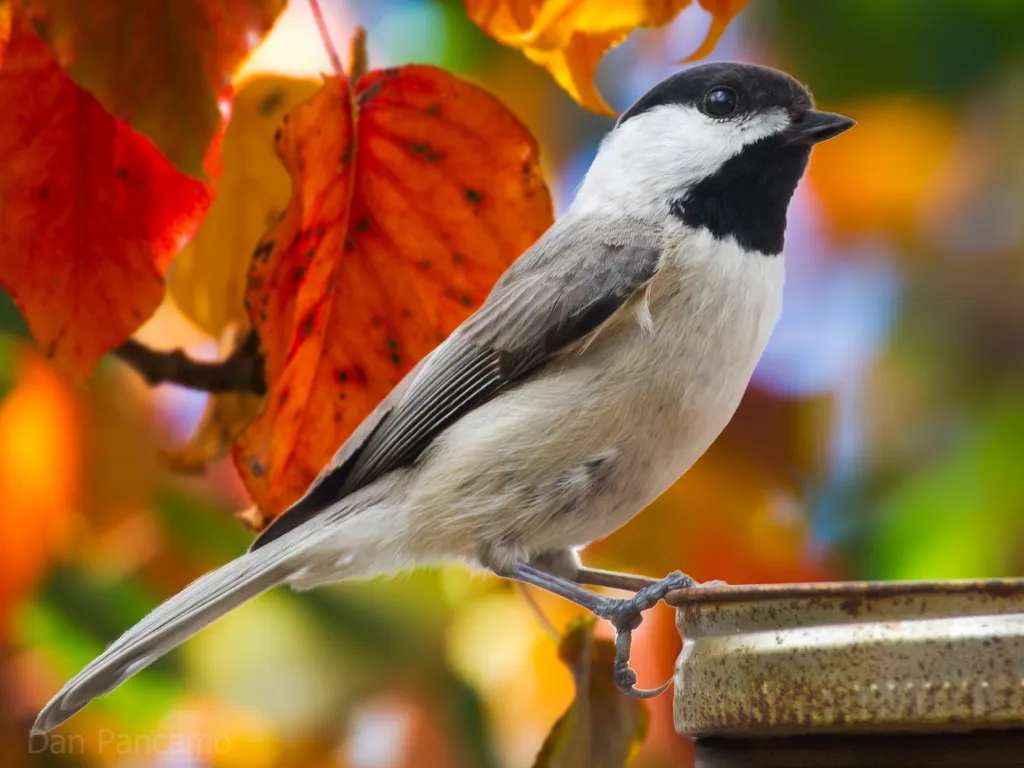
One of the most popular backyard birds you will see in Alabama, the Carolina chickadee has pale gray tails, wings, and back. It also has a black cap and white breast.
These small birds are not shy. They are present even where humans are. Some of the most common places where you will find them include forested areas, as well as parks.
It is not difficult to attract Carolina chickadees to the backyard. They are not picky when it comes to feeders, but they prefer those packed with black oil sunflower seeds, crushed peanuts, and suet.
17. American Robin

These common backyard birds in the Cotton State are often seen hopping on the ground, especially when there is grass. They search for earthworms and other invertebrates to eat.
American robins stay in Alabama throughout the year. From the tundra to the forest, they inhabit a wide array of habitats.
Even if they are comfortable around people, they are not feeder birds. Instead, they like spending their time on the ground. They do not eat seeds.
The American robin has a sweet tooth. Some of its favorites are berries, fruits, and even cakes!
18. California Gull

With their white head, gray wings, dark eyes, and yellow legs, California gulls are easily recognizable.
A California gull will forage whether it is flying, wading, swimming, or walking. It hovers and dips to pick up food. It can also follow plows in fields when searching for something to eat.
Speaking of its diet, California gulls eat insects, eggs, and fish. This common bird in Alabama can also scavenge through garbage dumps.
19. Barn Swallow

Present in Alabama during the breeding season, barn swallows are in the state from March to November.
The barn swallow is a tiny bird with an average length of 5.9 to 7.5 inches. When it is flying, the wings span at a width of 11.4 to 12.6 inches.
In terms of color, this bird has a deep blue tail, back, and wings. The lower body is reddish-brown, as well as some areas of the face. Meanwhile, there is a deep fork in the outer tail feathers.
If you are searching for barn swallows in Alabama, some of the best places to visit are farms, fields, and meadows. They also frequent in artificial structures like barns.
20. Summer Tanager

The summer tanager is one of the best bird photography subjects in Alabama. Males are bright red, making them stand out. Females, on the other hand, are yellow with hints of green at the back.
You will only see them in the state from April to October, which is also their breeding season. Look for them in open woodlands. They are frequent in areas with willow, cottonwood, pine, oak, and mesquite.
The bird spends most of its time perching on high tree canopies. They will sit still and catch insects mid-air when they are ready to eat.
21. Ruby-Crowned Kinglet
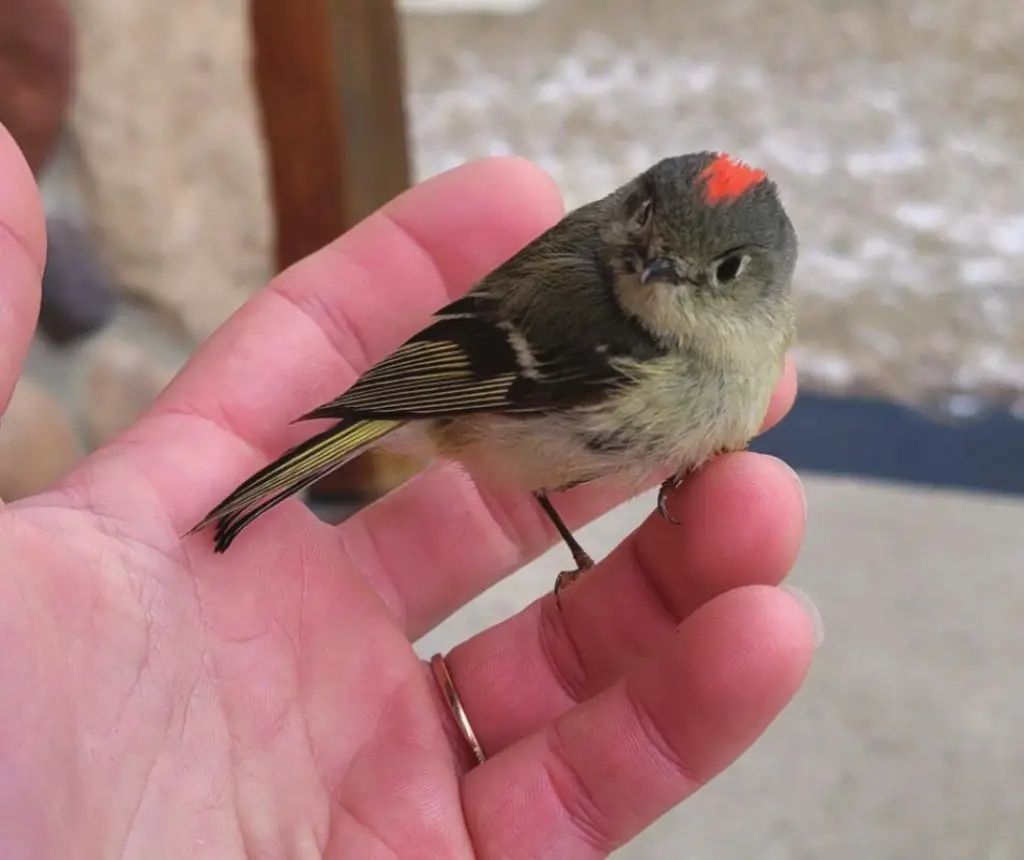
As its name implies, the ruby-crowned kinglet has a ruby cap, but it is only in males and not always visible. Most of its body is olive green. These birds have a white wing bar and eye-ring, as well as a large head, thin tail, and almost no neck.
Ruby-crowned kinglets are known for being restless and acrobatic, making them a joy to watch in flight. They are constantly flicking their wings when flying.
As for their breeding grounds, they prefer dense conifer forests, including those with tamarack, fir, and spruce. In the winter, you will find them even in parks.
22. Eastern Phoebe
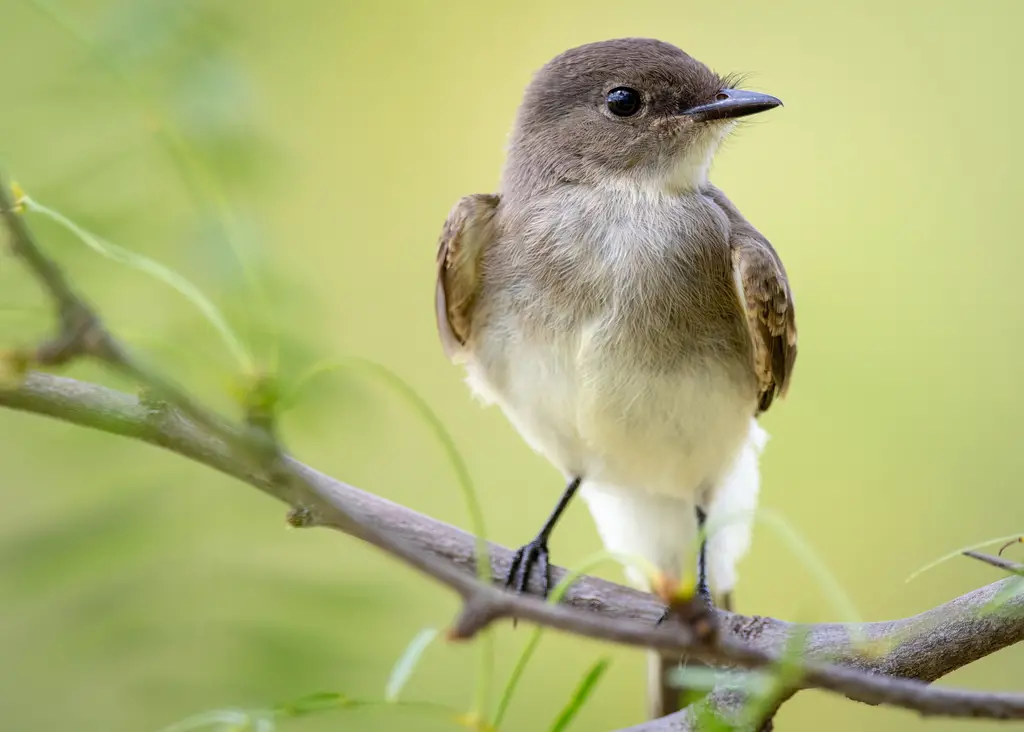
It may not be as popular as the other birds on this list, but it is one of the most common that you will find in Alabama.
The eastern phoebe has a pale brown or gray upper part with no wing bars. The underpart is white. Meanwhile, it sports a straight black bill.
Like other phoebes, they are known for being energetic. They spend a lot of time on short flights trying to capture insects to eat. They also have sharp vocalizations, making them easily recognizable even before they are seen.
Is the eastern phoebe a part of your Alabama birding itinerary? Then make sure that you head to woodlands, parks, and yards. They are also frequent in bridges and buildings where they build their nests.
23. American Goldfinch
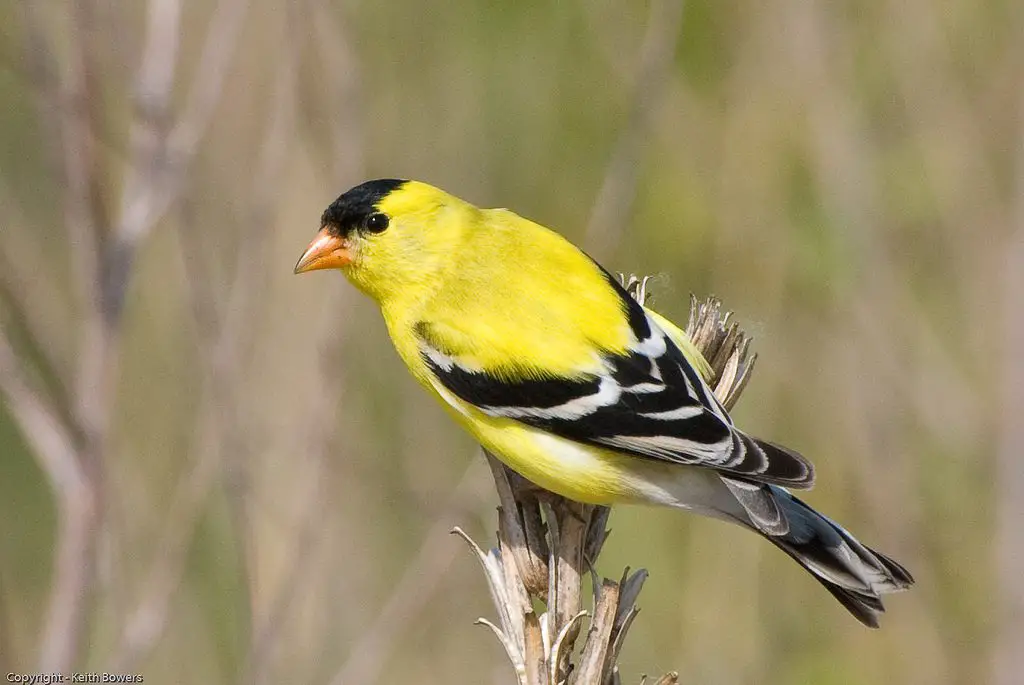
When people talk about the most beautiful birds in Alabama, it is impossible not to mention the American goldfinch.
Males are bright yellow in the winter, accentuated with black wings and caps. Females do not have a cap and are duller. Meanwhile, in the winter, both sexes turn pale brown or olive.
Add color to your backyard by attracting American goldfinches. They will visit bird feeders with Nyjer and sunflower seeds. They also love backyards with milkweed and thistle.
The American goldfinch is a vegetarian. Hence, unlike most other feeder birds, it will not eat seeds.
24. Common Grackle
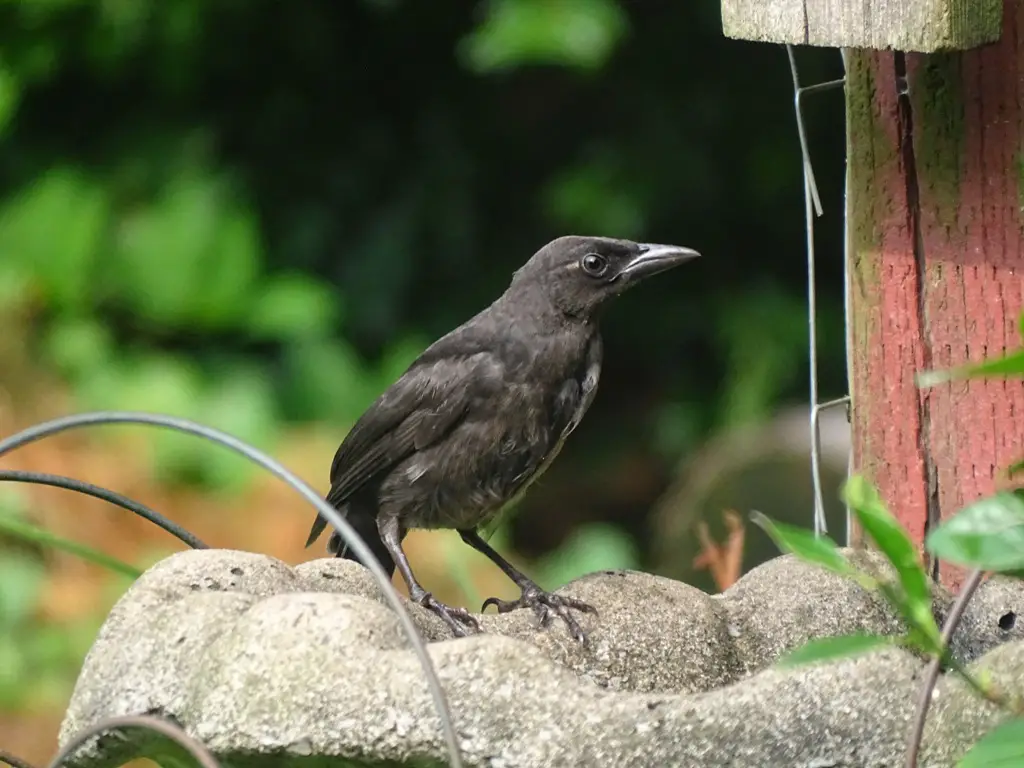
While they have a near-threatened status, it is still possible to see a common grackle in Alabama throughout the year. Nonetheless, the sightings are not as frequent as the others on this list.
These large blackbirds have long tails and bills. Males have black bodies. With the right lighting, however, you will notice its iridescent bronze body and blue head. Meanwhile, females have almost the same color, but they are not as glossy as males.
It is common to see the common grackle in large flocks. They congregate in open fields with crops like rice and corn, which are their favorite foods. They can also eat acorns, fruits, insects, and even other birds.
25. European Starling

While they are not native birds, European starlings are among the most widespread birds in Alabama. Sadly, a lot of homeowners do not like having them in the backyard because starlings are invasive species.
The European starling is about the size of an American robin. It has a black plumage that looks shiny in light and with hints of blue, green, and purple. The bird has a long slender beak and short tail.
European starlings are adaptable, so they can live even where humans are. They can also eat almost anything.
26. White-Breasted Nuthatch

While they are tiny birds, white-breasted nuthatches are known for being active. The average length of the bird ranges from 5.1 to 5.5 inches.
The white-breasted nuthatch is identifiable through its blue-gray back, black cap, and white belly and face. Plus, it has chestnut hues under the tail and on the belly.
If the white-breasted nuthatch is in your Alabama birding itinerary, make sure to visit woodland edges and deciduous forests. They are also frequent visitors to private parks and yards.
In the backyard, you can lure them into suet feeders and tube feeders.
27. Red-Tailed Hawk

Birds of prey are also common in Alabama, and one of the most popular is the red-tailed hawk. It is amongst the most widespread hawks in North America.
These raptors have broad and rounded wings and short and wide tails. Meanwhile, they are rich brown in the upper body and pale underneath. There is also a dark bar between its wrist and shoulder.
It is common to see red-tailed hawks hovering in circles above open fields. They are also often perched on fence posts and telephone wires.
28. Indigo Bunting
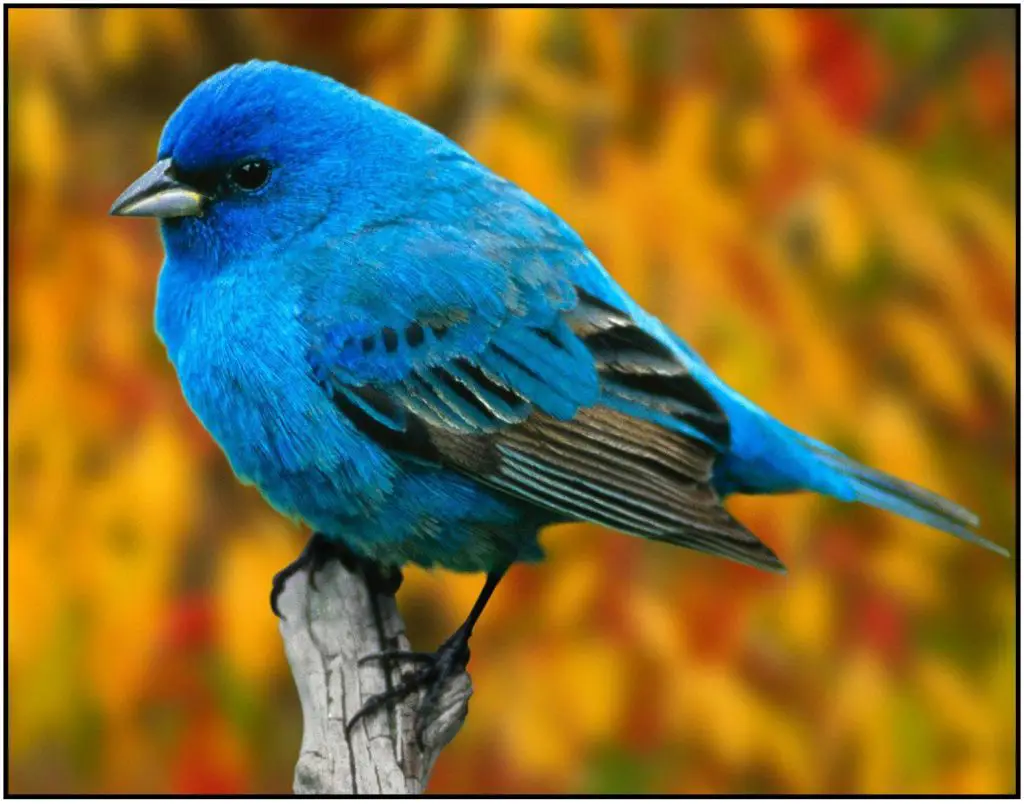
Seeing an indigo bunting in Alabama is guaranteed to be a visual treat. Males are all-blue, making them easy to spot even if they are small. Meanwhile, females are brown with faint streaks on the breast.
The diet of an indigo bunting includes berries, seeds, and insects. Alternatively, they will also visit backyards with thistle and Nyjer seeds.
Weedy and brushy locations are the preferred habitats of indigo buntings. They like brushy roadsides and overgrown patches.
Roaming Tip: Don’t feel tired just yet! Flex your eye muscles as we continue to visit our next state here — Birds Of Iowa.
Watch This!
Frequently Asked Questions
How many species of birds live in Alabama?
According to the Alabama Ornithological Society, there are 420 bird species in the state. Out of this, 178 species are breeding in the state. Meanwhile, 174 species are in the state during the winter. The birds in the state are from different families, including blackbirds, finches, nuthatches, flycatchers, herons, owls, pigeons, starlings, and woodpeckers.
What birds are yellow in Alabama?
The Heart of Dixie is home to an array of yellow birds, including yellow-rumped warbler, northern parula, cedar waxwing, common yellowthroat, great-crested flycatcher, pine warbler, and American goldfinch.
Conclusion
From national forests to wildlife refuges, Alabama is gifted with diverse landscapes that attract birds. Many of these species are in the state throughout the year while others are only migratory. You can even attract them to your yard with the right backyard feeders.
Are there other Alabama birds that we missed? Let us know in the comments below.

